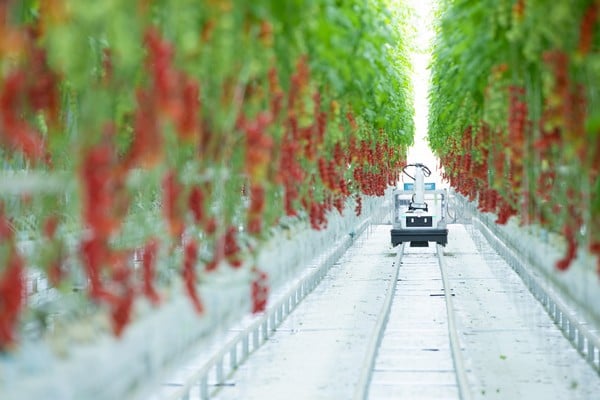
At the moment, the grower often sees their crops every day. In the case of roses, harvesting even takes place twice a day. And in the case of tomatoes, too, someone walks through the greenhouse several times a week to harvest the produce. If that no longer happens in the future because a robot will do the harvesting autonomously, then that will change. On the face of it, that seems like a good thing. However, an experienced employee who goes into the greenhouse to harvest is doing more than just cutting roses or picking tomatoes. The employee notices if a crop is not growing as well in a certain spot. Diseases and pests are also spotted and registered.
Seeing
What if there are hardly any people who come into the greenhouse anymore? You could, of course, have someone enter the greenhouse several times a week to check the plants, but that is a costly endeavor. It would be preferable if the harvesting robots could also take on this task. They often “look” at the crop anyhow in order to determine which tomatoes are ripe. A lot is already possible when vision technology is combined with the knowledge of the grower in an AI system. In fact, there are already systems under development that do this.
Even better is to take it a step further. Not just looking to see how the crops are doing, but applying new technology as well. Vision technology is leading the way here. Much is already possible by looking at other wavelengths of the spectrum than those that humans can see. Examples include determining the ripeness, inner quality and sweetness (Brix value) of a fruit.
Smelling
But what if you can actually observe much more? If you could not only see but also smell the state of health of a plant? Work is already underway on this application. Several companies are developing an electronic nose, or e-nose. Volatile organic compounds (VOCs) can be measured with this device. A plant that is attacked by aphids spreads certain odorants to warn its fellow plants in the area. This enables its peers to produce antibodies that make them less attractive to the aphids. Detecting these types of VOCs can also be done using a gas chromatograph. However, these are often large pieces of equipment and the odorants still need to be transported to them. Therefore, not particularly practical in a greenhouse.
E-nose
Right now, NXP is teaming up with Koppert Biological Systems, Canopy Guard and Delft University of Technology in the project ‘Tiny e-nose for fine grid early detection of crop infestation‘. Microchips are being developed that are capable of detecting various pests. This detection is done using different types of ink that can react to a specific combination of VOCs. By attaching these chips to drones, robots or into a fine mesh grid in the greenhouse, pests can be detected at a very early stage. Not only is this a solution for the times when there are (almost) no staff inside a greenhouse. It also makes it possible to detect pests that are not yet visible because the infestation starts underneath a leaf, for example. This means that interventions can be made much earlier to make sure that the plants grow under optimum conditions.
Bee trainer
Incidentally, this consortium is not the only one working on this front. The company InsectSense detects VOCs with the help of bees. They use the highly sensitive odor receptors of these insects to do this. A special training tool has been developed to teach the bees to recognize a particular odor in a matter of minutes.
Before the products of both projects can really be put to practical use, a lot of research still needs to be done. However, both are a great example of where technology not only replaces humans but can do things that humans cannot, in this case – smell the health of the plant!
The smell of rain
Also, although we humans may not have as strong an olfactory organ as bees, we can do it too! As it happens, the name of this phenomenon is also beautiful, “Petrichor“. Just think of the smell you smell when it rains after a long period of dry weather. Chances are you immediately recognize that smell, even though you had no idea until now that it was the smell produced by microbes, including the bacterium Streptomyces. It continues to be fascinating how nature and technology come together….
About this column
In a weekly column, alternately written by Willemijn Brouwer, Eveline van Zeeland, Eugène Franken, Helen Kardan, Katleen Gabriels, Carina Weijma, Bernd Maier-Leppla and Colinda de Beer, Innovation Origins tries to figure out what the future will look like. These columnists, sometimes joined by guest bloggers, are all working in their own way to find solutions to the problems of our time. So tomorrow will be good. Here are all the previous articles.

